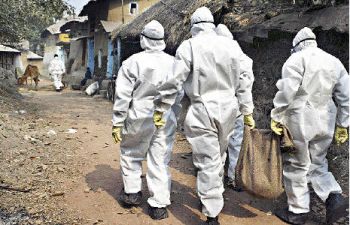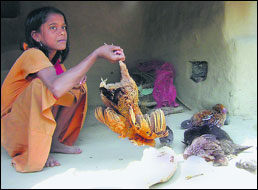H5N1 in poultry in India spiraling out of control; BBC boots on the ground
 I have not posted anything on the worsening situation in India because, quite frankly, the scope of it is so huge that it took me days to come to terms with it.
I have not posted anything on the worsening situation in India because, quite frankly, the scope of it is so huge that it took me days to come to terms with it.
Specifically, the area is West Bengal, a state located along the nation’s border with Bangladesh. It is some 33,000 square miles, just larger in area than South Carolina. When you combine affected areas of adjacent Bangladesh, the region is about the same size and shape as Maine. It has the third-best economy in India, and is home to more than 80,000,000 people, or roughly 8% of the nation’s population. Its capital is Kolkata, or what we used to call Calcutta.
So what is going on in West Bengal? Chaos. Tens of thousands of chickens have literally dropped dead in the past month. Thousands of dead, diseased fowl litter the streets of rural villages in West Bengal. It is the worst outbreak of H5N1 in India’s history, a fact confirmed by the WHO. And it is centered around backyard poultry as well as larger farms. Across the border in Bangladesh, similar events are occurring.
The Indian government has taken the task seriously, using the words ‘war footing” and calling up literally thousands of veterinarians to help supervise the culling of what will certainly wind up being nearly two million chickens. The Indian equivalent of the National Guard has been called up to help stop the smuggling of poultry into and out of the West Bengal area. And the Indian government has made the decision to try and cull migratory wildfowl as well as chickens.
But farmers and villagers alike are resisting the government’s efforts to combat the virus. In acts of insane defiance, many are cooking and eating poultry they strongly suspect is diseased. They are hiding birds from the authorities, and are demanding immediate compensation for the birds being culled. In some cases, they are attacking the cullers as they approach.
They are also furious at what they perceive to be an initial lackluster response from the West Bengal government. Rumors abound that chickens had been dying for weeks prior to the discovery of H5N1.
 Naturally, the sudden loss of so many birds has caused shockwaves through the Indian markets, both poultry and stock. For a nation that as a general rule does not eat beef, this is putting one of the two main protein sources (the other is mutton) for over one billion people in serious jeopardy. Contrary to popular belief, only 31% of Indians are vegetarians, according to a 2006 survey performed by the Hindu newspaper and CNN-IBN. While some 55% of Brahmins are vegetarians, most Hindus are non-vegetarians. This means that the loss of two million chickens will create a tough situation for those rural villagers who rely upon chickens for sustenance. http://www.hinduonnet.com/2006/08/14/stories/2006081403771200.htm
Naturally, the sudden loss of so many birds has caused shockwaves through the Indian markets, both poultry and stock. For a nation that as a general rule does not eat beef, this is putting one of the two main protein sources (the other is mutton) for over one billion people in serious jeopardy. Contrary to popular belief, only 31% of Indians are vegetarians, according to a 2006 survey performed by the Hindu newspaper and CNN-IBN. While some 55% of Brahmins are vegetarians, most Hindus are non-vegetarians. This means that the loss of two million chickens will create a tough situation for those rural villagers who rely upon chickens for sustenance. http://www.hinduonnet.com/2006/08/14/stories/2006081403771200.htm
Because of a shortage of supplies, these culls are taking gruesome form. Birds’ necks are being broken to kill them, and workers may or may not have protective equipment.
So it was not surprising that we would soon start hearing reports of people being hospitalized with bird flu symptoms. These reports are, at least for now, confined to cullers and children. Thousands of courses of Tamiflu have been sent into the West Bengal state for precautionary purposes, according to Indian media reports.
Shockwaves are also being felt in the wildlife community. Media reports of dead and dying crows, hawks, owls, vultures, dogs, pigs and other animals are unsettling to say the least. And the images of the dying tigers at the Bangkok Zoo a few years ago (you recall with horror as over forty tigers died from eating H5N1-contaminated meat) could be rekindled if diseased birds are eaten by those magnificent Bengal tigers.
Coincidentally, HHS Secretary Mike Leavitt was recently in India, looking at vaccine and health care facilities and factories that produce goods for the US market. Talk about being in the right place at the right time! (thanks to treyfish for that tidbit).
Now the BBC has reporters at Ground Zero of the outbreak.
West Bengal battles with bird flu
By Rahul Tandon
BBC News, Margram
Margram is a large village in West Bengal - it is also the epicentre of the bird flu outbreak.
 As I walk into the village, I can see a group of young children playing in the fields. Next to them are dead chickens. Some of the children are picking up the dead bird's feathers to sell. They have no idea of the dangers of touching infected birds.
As I walk into the village, I can see a group of young children playing in the fields. Next to them are dead chickens. Some of the children are picking up the dead bird's feathers to sell. They have no idea of the dangers of touching infected birds.
Next to them, sat outside his hut, is an old man. Anwar Hoque has his head in his hands. As I walk past he starts shouting: "We have no help from the government - we want medicines but they are not providing us with them and we have cannot afford to buy them from the shops."
There is no sign of the flu anti-viral Tamiflu here.
Slow progress
What strikes me about this rural village is the lack of government officials.
Many of the 60,000 people who live here keep chickens - indeed some estimate that there were 150,000 chickens in this village before the outbreak of bird flu. For many, poultry farming is their only source of income. Yet very few know anything about avian flu - and there seem to be few officials on hand to provide these villagers with information.
After walking around the village for 15 minutes I finally see a team of men in protective white suits. They are part of the culling team. The state government here in West Bengal has ordered the culling of 400,000 birds.
But progress is very slow. The man leading this team is Dr Ramchandratta. He tells me this morning they have only killed five birds.
He is angry with the villagers and says: "They are not interested in handing over their birds and that is making life very hard for us." In front of me, one of his team has a young chick in his hand and is surrounded by a group of children.
He kills it by breaking its neck.
'Chaotic'
As I walk away Dr Ramchandratta asks me to come back. He tells me he is a "soldier of the government" and he is trying his best but people are not listening to him. There are stories here of some villagers smuggling birds out to other areas and even of some culling teams being attacked.
It is a chaotic scene. Just outside the village is a large yellow building. It is from here that Kakoli Mukherjee is directing operations to tackle the problem. Sitting at her desk, she is surrounded by villagers.
She accepts that there are problems, but says: "none of us have any experience of dealing with this disease". Avian flu is spreading across West Bengal.
As I drive out of Margram it is clear that unless the villagers and the local government start working together this problem can only get worse.
The article can be read at this link:
http://news.bbc.co.uk/2/hi/south_asia/7198985.stm
A Google map from Dr. Henry Niman shows the locations of confirmed and suspected poultry H5N1:
http://maps.google.com/maps/ms?ie=UTF8&hl=en&msa=0&msid=106484775090296685271.0004353ecc9cb8856de8c&om=0&ll=23.402765,89.604492&spn=8.181367,13.491211&t=h&z=6
Reader Comments (5)
"They have no idea of the dangers of touching infected birds."
Actually, the risk to human from handling or eating chickens that died of H5N1 is extremely low. It is currently very difficult for humans to become infected with this virus, even if they are covered with infected blood.
What have you done to prevent the flu at your house?
Are all your information true??
It sends chills through my bones....
Is all your information true??
It sends chills through my bones....
Is this outbreak linked to the mass deaths of vultures? Crows are not as well equipped to handle the biohazards of carrion that they now take over this job along with dogs and rats.